Related Research Articles

Analytical chemistry studies and uses instruments and methods to separate, identify, and quantify matter. In practice, separation, identification or quantification may constitute the entire analysis or be combined with another method. Separation isolates analytes. Qualitative analysis identifies analytes, while quantitative analysis determines the numerical amount or concentration.
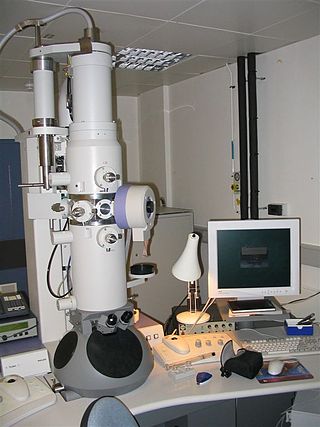
An electron microscope is a microscope that uses a beam of accelerated electrons as a source of illumination. As the wavelength of an electron can be up to 100,000 times shorter than that of visible light photons, electron microscopes have a higher resolving power than light microscopes and can reveal the structure of smaller objects. A scanning transmission electron microscope has achieved better than 50 pm resolution in annular dark-field imaging mode and magnifications of up to about 10,000,000× whereas most light microscopes are limited by diffraction to about 200 nm resolution and useful magnifications below 2000×.

Microscopy is the technical field of using microscopes to view objects and areas of objects that cannot be seen with the naked eye. There are three well-known branches of microscopy: optical, electron, and scanning probe microscopy, along with the emerging field of X-ray microscopy.

A scanning electron microscope (SEM) is a type of electron microscope that produces images of a sample by scanning the surface with a focused beam of electrons. The electrons interact with atoms in the sample, producing various signals that contain information about the surface topography and composition of the sample. The electron beam is scanned in a raster scan pattern, and the position of the beam is combined with the intensity of the detected signal to produce an image. In the most common SEM mode, secondary electrons emitted by atoms excited by the electron beam are detected using a secondary electron detector. The number of secondary electrons that can be detected, and thus the signal intensity, depends, among other things, on specimen topography. Some SEMs can achieve resolutions better than 1 nanometer.
Extractive metallurgy is a branch of metallurgical engineering wherein process and methods of extraction of metals from their natural mineral deposits are studied. The field is a materials science, covering all aspects of the types of ore, washing, concentration, separation, chemical processes and extraction of pure metal and their alloying to suit various applications, sometimes for direct use as a finished product, but more often in a form that requires further working to achieve the given properties to suit the applications.
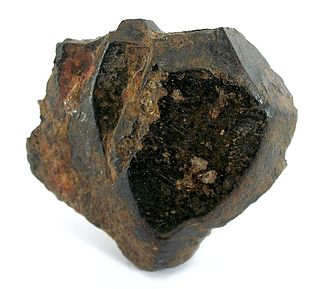
Ilmenite is a titanium-iron oxide mineral with the idealized formula FeTiO
3. It is a weakly magnetic black or steel-gray solid. Ilmenite is the most important ore of titanium and the main source of titanium dioxide, which is used in paints, printing inks, fabrics, plastics, paper, sunscreen, food and cosmetics.
Image analysis or imagery analysis is the extraction of meaningful information from images; mainly from digital images by means of digital image processing techniques. Image analysis tasks can be as simple as reading bar coded tags or as sophisticated as identifying a person from their face.
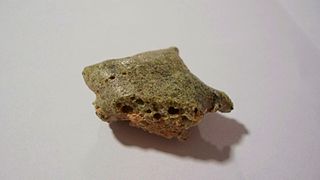
Trinitite, also known as atomsite or Alamogordo glass, is the glassy residue left on the desert floor after the plutonium-based Trinity nuclear bomb test on July 16, 1945, near Alamogordo, New Mexico. The glass is primarily composed of arkosic sand composed of quartz grains and feldspar that was melted by the atomic blast. It was first academically described in American Mineralogist in 1948.

Clay minerals are hydrous aluminium phyllosilicates (e.g. kaolin, Al2Si2O5(OH)4), sometimes with variable amounts of iron, magnesium, alkali metals, alkaline earths, and other cations found on or near some planetary surfaces.
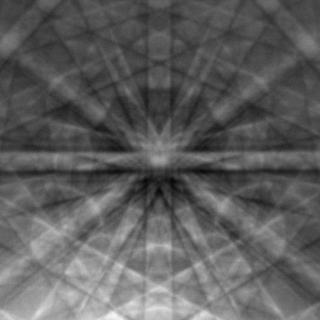
Electron backscatter diffraction (EBSD) is a scanning electron microscope (SEM) technique used to study the crystallographic structure of materials. EBSD is carried out in a scanning electron microscope equipped with an EBSD detector comprising at least a phosphorescent screen, a compact lens and a low-light CCD camera. In this configuration, the SEM incident beam hits the tilted sample. As backscattered electrons leave the sample, they interact with the crystal’s periodic atomic lattice planes and diffract according to Bragg's law at various scattering angles before reaching the phosphor screen forming Kikuchi patterns (EBSPs).
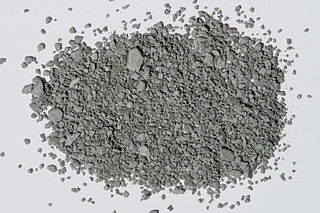
Illite is a group of closely related non-expanding clay minerals. Illite is a secondary mineral precipitate, and an example of a phyllosilicate, or layered alumino-silicate. Its structure is a 2:1 sandwich of silica tetrahedron (T) – alumina octahedron (O) – silica tetrahedron (T) layers. The space between this T-O-T sequence of layers is occupied by poorly hydrated potassium cations which are responsible for the absence of swelling. Structurally, illite is quite similar to muscovite with slightly more silicon, magnesium, iron, and water and slightly less tetrahedral aluminium and interlayer potassium. The chemical formula is given as (K,H3O)(Al,Mg,Fe)2(Si,Al)4O10[(OH)2·(H2O)], but there is considerable ion (isomorphic) substitution. It occurs as aggregates of small monoclinic grey to white crystals. Due to the small size, positive identification usually requires x-ray diffraction or SEM-EDS analysis. Illite occurs as an altered product of muscovite and feldspar in weathering and hydrothermal environments; it may be a component of sericite. It is common in sediments, soils, and argillaceous sedimentary rocks as well as in some low grade metamorphic rocks. The iron-rich member of the illite group, glauconite, in sediments can be differentiated by x-ray analysis.

Gunshot residue (GSR), also known as cartridge discharge residue (CDR), gunfire residue (GFR), or firearm discharge residue (FDR), consists of all of the particles that are expelled from the muzzle of a gun following the discharge of a bullet. It is principally composed of burnt and unburnt particles from the explosive primer, the propellant (gunpowder), and vaporized lead. The act of firing a bullet incites a very violent explosive reaction that is contained within the barrel of the gun, which can cause the bullet, the barrel, or the cartridge to become chipped. Meaning gunshot residue may also included metal fragments from the cartridge casing, the bullets jacket, as well as any other dirt or residue contained within the barrel that could have become dislodged.

Fractography is the study of the fracture surfaces of materials. Fractographic methods are routinely used to determine the cause of failure in engineering structures, especially in product failure and the practice of forensic engineering or failure analysis. In material science research, fractography is used to develop and evaluate theoretical models of crack growth behavior.

The environmental scanning electron microscope (ESEM) is a scanning electron microscope (SEM) that allows for the option of collecting electron micrographs of specimens that are wet, uncoated, or both by allowing for a gaseous environment in the specimen chamber. Although there were earlier successes at viewing wet specimens in internal chambers in modified SEMs, the ESEM with its specialized electron detectors and its differential pumping systems, to allow for the transfer of the electron beam from the high vacuum in the gun area to the high pressure attainable in its specimen chamber, make it a complete and unique instrument designed for the purpose of imaging specimens in their natural state. The instrument was designed originally by Gerasimos Danilatos while working at the University of New South Wales.
Aspex Corporation, founded in 1992, is a supplier of electron microscopy tools to researchers, developers and manufacturers working on Process control through automated scanning electron microscope and energy-dispersive X-ray spectroscopy.
QEMSCAN is the name for an integrated automated mineralogy and petrography system providing quantitative analysis of minerals, rocks and man-made materials. QEMSCAN is an abbreviation standing for quantitative evaluation of minerals by scanning electron microscopy, and a registered trademark owned by FEI Company since 2009. Prior to 2009, QEMSCAN was sold by LEO, a company jointly owned by Leica and ZEISS. The integrated system comprises a scanning electron microscope (SEM) with a large specimen chamber, up to four light-element energy-dispersive X-ray spectroscopy (EDS) detectors, and proprietary software controlling automated data acquisition. The offline software package iDiscover provides data processing and reporting functionality.

Synopsys Simpleware ScanIP is a 3D image processing and model generation software program developed by Synopsys Inc. to visualise, analyse, quantify, segment and export 3D image data from magnetic resonance imaging (MRI), computed tomography (CT), microtomography and other modalities for computer-aided design (CAD), finite element analysis (FEA), computational fluid dynamics (CFD), and 3D printing. The software is used in the life sciences, materials science, nondestructive testing, reverse engineering and petrophysics.

Chamosite is the Fe2+end member of the chlorite group. A hydrous aluminium silicate of iron, which is produced in an environment of low to moderate grade of metamorphosed iron deposits, as gray or black crystals in oolitic iron ore. Like other chlorites, it is a product of the hydrothermal alteration of pyroxenes, amphiboles and biotite in igneous rock. The composition of chlorite is often related to that of the original igneous mineral so that more Fe-rich chlorites are commonly found as replacements of the Fe-rich ferromagnesian minerals (Deer et al., 1992).
Provenance in geology, is the reconstruction of the origin of sediments. The Earth is a dynamic planet, and all rocks are subject to transition between the three main rock types: sedimentary, metamorphic, and igneous rocks. Rocks exposed to the surface are sooner or later broken down into sediments. Sediments are expected to be able to provide evidence of the erosional history of their parent source rocks. The purpose of provenance study is to restore the tectonic, paleo-geographic and paleo-climatic history.
Electron channelling contrast imaging (ECCI) is a scanning electron microscope (SEM) diffraction technique used in the study of defects in materials. These can be dislocations or stacking faults that are close to the surface of the sample, low angle grain boundaries or atomic steps. Unlike the use of transmission electron microscopy (TEM) for the investigation of dislocations, the ECCI approach has been called a rapid and non-destructive characterisation technique
References
- ↑ Goodall, W.R., Scales, P.J., Butcher, A.R. 2005. The use of QEMSCAN and diagnostic leaching in the characterisation of visible gold in complex ores. Minerals Engineering, 18, 8, 877-886 doi:org/10.1016/j.mineng.2005.01.018
- ↑ Fröhlich, S., Redfern, J., Petitpierre, L., J.D. Marshall, M. Power, Grech, P. 2010. Diagenetic evolution of incised channel sandstones: implications for reservoir characterisation of the Lower Carboniferous Marar Formation, Ghadames Basin, Western Libya. Journal of Petroleum Geology, 33; 3-18. abstract
- ↑ Liu, Y., Gupta, R., Sharma, A., Wall, T., Butcher, A., Miller, G., Gottlieb, P., French, D. 2005. Mineral matter–organic matter association characterisation by QEMSCAN and applications in coal utilisation. Fuel, 84, 10, 1259–1267. doi : 10.1016/j.fuel.2004.07.015
- ↑ Haberlah, D., Williams, M.A.J., Halverson, G., Hrstka, T., Butcher, A.R., McTainsh, G.H., Hill, S.M., Glasby, P. 2010. Loess and floods: high-resolution multi-proxy data of Last Glacial Maximum (LGM) slackwater deposition in the Flinders Ranges, semi-arid South Australia. Quaternary Science Reviews, 29, 19-20, 2673–2693. doi : 10.1016/j.quascirev.2010.04.014
- ↑ Pirrie, D., Power, M.R., Rollinson, G.K., Wiltshire, P.E.J., Newberry, J., Campbell, H.E. 2005. Automated SEM-EDS (QEMSCAN) Mineral Analysis in Forensic Soil Investigations: Testing Instrumental Reproducibility. In:K. Ritz et al. (eds.) Criminal and Environmental Soil Forensics, 84, 10, 411-430, Springer Science doi:org/10.1007/978-1-4020-9204-6_26
- ↑ Knappett, C., Pirrie, D., Power, M.R., Nikolakopoulou, I., Hilditch, J., Rollinson, G.K. 2005. Mineralogical analysis and provenancing of ancient ceramics using automated SEM-EDS analysis (QEMSCAN): A pilot study on LB I pottery from Akrotiri, Thera. Journal of Archaeological Science, in press [ permanent dead link ] doi : 10.1016/j.jas.2010.08.022
- ↑ Schrader, C.M., Rickman, D., Stoeser, D., Wentworth, S.J., Botha, P.W.S.K., Butcher, A.R., McKay, D., Horsch, H., Benedictus, A., Gottlieb, P. 2008. Analysis of Lunar Highland Regolith Samples from Apollo 16 Drive Core 64001/2 and Lunar Regolith Simulants - An Expanding Comparative Database. NASA Technical Report, MSFC-2144 abstract
- ↑ Sutherland, D., Gottlieb, P., Jackson, R., Wilkie, G., Stewart, P. 1988. Measurement in section of particles of known composition. Minerals Engineering, 1, 4, 317-326. doi : 10.1016/0892-6875(88)90021-0
- ↑ Sutherland, D.N., Gottlieb, P. 1991. Application of automated quantitative mineralogy in mineral processing . Minerals Engineering, 4, 7-11, 753-762. doi : 10.1016/0892-6875(91)90063-2
- ↑ "Minerals Engineering Conferences - Automated Mineralogy 06".